Middle East & Africa Defense Market Size
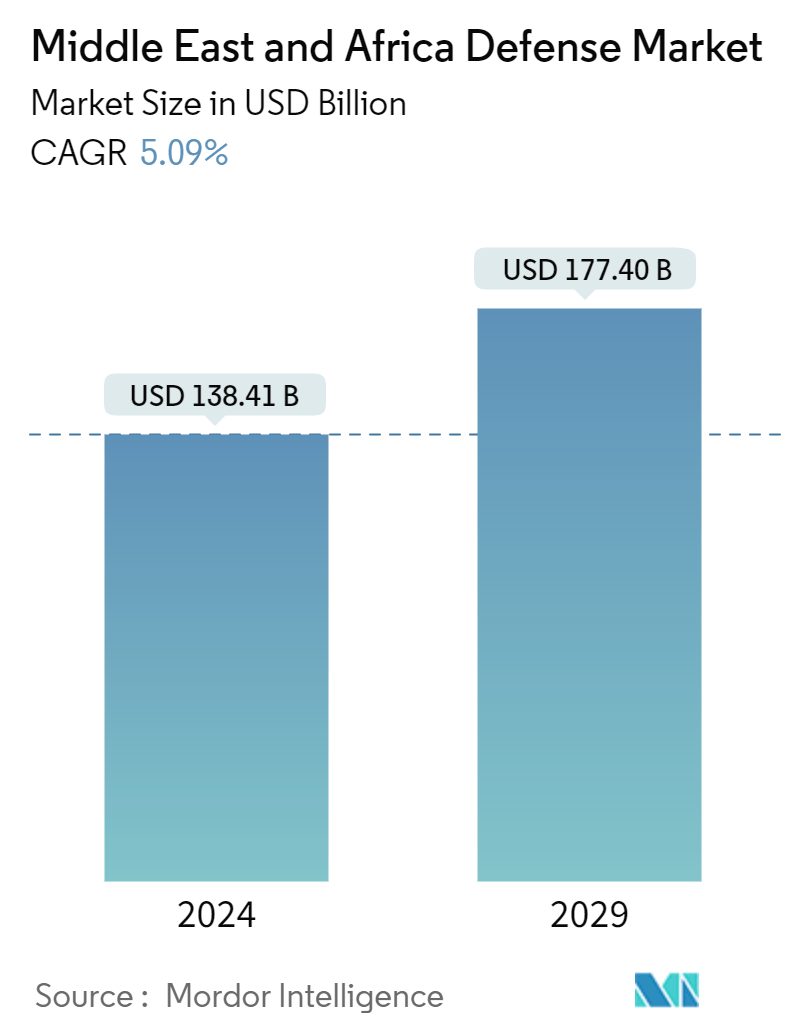
| Study Period | 2019 - 2029 |
| Market Size (2024) | USD 138.41 Billion |
| Market Size (2029) | USD 177.40 Billion |
| CAGR (2024 - 2029) | 5.09 % |
| Fastest Growing Market | Middle East |
| Largest Market | Middle East |
Major Players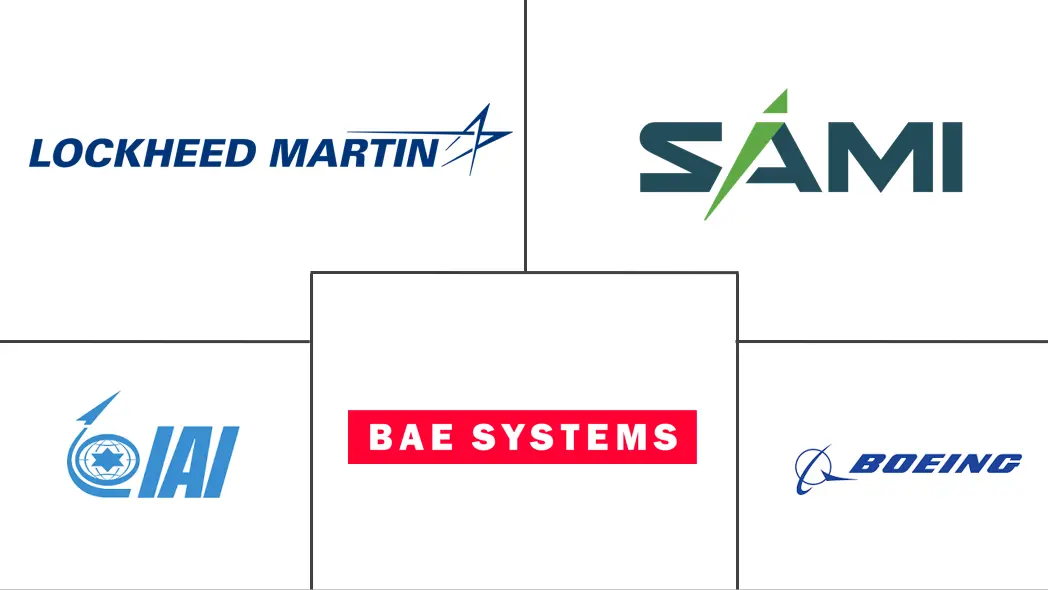
*Disclaimer: Major Players sorted in no particular order |
Middle East And Africa Defense Market Analysis
The Middle East And Africa Defense Market size is estimated at USD 138.41 billion in 2024, and is expected to reach USD 177.40 billion by 2029, growing at a CAGR of 5.09% during the forecast period (2024-2029).
The Middle East and African defense market is recording a rise in defense spending, fueled by increasing geopolitical tensions, local and regional conflicts, and increased spending by major countries. Saudi Arabia, the United Arab Emirates, Israel, and Egypt top this list as they continue to pour billions of dollars into the modernization of their military equipment.
The MEA defense market is increasingly focused on advanced technology inlay, ranging from artificial intelligence integration to cyber warfare capabilities and electronic warfare systems. The region is also witnessing the escalation of cooperation with leading global defense manufacturers for technology transfer and local production.
One of the most prominent drivers of the MEA defense market is the geopolitical instability and regional conflicts that prevail at a very high level. Countries within the Middle East and Africa are often embroiled in border disputes, internal conflicts, and counter-terrorism operations that require them to invest heavily in the modernization and expansion of their defense capabilities. For example, ongoing tensions between Iran and several GCC countries, as well as conflicts in Yemen, Libya, and Syria, have made countries like Saudi Arabia, the United Arab Emirates, and Israel focus on defense spending. These countries acquire advanced military hardware, including missile defense systems, fighter jets, and unmanned aerial vehicles (UAVs), to strengthen strategic deterrence and operational readiness. Such advanced defense technology contributes to national security and fosters regional stability; hence, demand for cutting-edge defense solutions is surging.
A major challenge facing the Middle East and African (MEA) defense market is the intricate balance between advancing defense capabilities and addressing fiscal constraints amid economic uncertainties. The fluctuating oil prices, exacerbated by geopolitical tensions and global economic fluctuations, significantly impact the defense budgets of oil-dependent economies in the region. For instance, the recent volatility in oil markets due to global economic slowdowns and shifts in energy policies has put pressure on defense spending. While investing heavily in defense modernization, countries like Saudi Arabia and the United Arab Emirates face the challenge of sustaining high defense expenditures while investing in economic diversification and infrastructure projects as part of their Vision 2030.
Additionally, the region's reliance on foreign defense suppliers and the complexities associated with international defense trade, including sanctions and export control regulations, further complicate procurement processes. The dynamic geopolitical landscape, characterized by alliances and rivalries, adds another layer of complexity to defense acquisitions and strategic planning. For example, ongoing sanctions on countries like Iran and the potential for new sanctions on other regional players can disrupt supply chains and delay critical defense projects. These fiscal and geopolitical challenges require careful navigation to ensure that defense modernization efforts do not compromise broader economic stability and development goals.
Middle East And Africa Defense Market Trends
The Vehicles Segment to Experience the Highest Growth During the Forecast Period
The vehicle segment is expected to be a fast-growing segment in the Middle East and African defense market during the forecast period, mainly due to the growing threats to regional security, modernization programs, and technological advancements. The ongoing geopolitical tensions, as manifested through the conflicts in Yemen and Libya and counter-terrorism operations across the region, have brought about hefty investments in modern armored vehicles, given their enhanced protection, mobility, and firepower characteristics against advanced enemy threats in contemporary warfare and peacekeeping missions.
Countries such as Saudi Arabia and the United Arab Emirates are at the forefront, where the latter has ordered the most significant number of procurements to date, such as Oshkosh Defense's JLTVs and the modernization of existing fleets with state-of-the-art systems like Patria's AMV XP. The integration of advanced technologies like Active Protection Systems, C4ISR, and hybrid-electric propulsion systems is increasing demand for this segment even more. Other factors, like strategic cooperation and joint ventures between regional nations and significant defense firms, drive local production capacity. Such collaboration is best manifested in the deal between UAE's EDGE Group and Turkey's FNSS to produce Rabdan 8x8 vehicles. Emphasis on indigenization and self-reliance in defense manufacturing under broader initiatives, such as Saudi Arabia's Vision 2030, is significantly driving the development of the domestic defense industrial base for the growth of this segment. Moreover, the versatility of armored vehicles for various military operations, from conventional wars to counter-insurgency, coupled with an increasing focus on homeland security and law enforcement functions, significantly contributes to the market expansion.
While there has been a rise in geopolitical tensions, regional conflicts, and counter-terrorism operations, the versatility, operational efficiency, and less risk to personnel are making the defense forces adopt UAVs. Countries such as Saudi Arabia, the United Arab Emirates, and Israel are at the front end of making their defense arsenals saturated with UAVs, either with an indigenization program or through international cooperation. For example, the local production of the CH-4 and Wing Loong II UAVs by Saudi Arabia in collaboration with China and the extensive deployment of Heron and Hermes UAVs by Israel are examples of the current trend.
Rapid technological change, especially in UAVs, such as increased payload capacities, extended flight endurance, and advanced sensor systems, is remarkably expanding their operational scope. UAVs fitted with state-of-the-art electro-optical/infrared (EO/IR) sensors, synthetic aperture radar (SAR), and electronic warfare (EW) systems provide unmatched situational awareness and precision strike capabilities. Moreover, the integration of AI and ML algorithms enables autonomous operations and real-time data processing, further enriching mission effectiveness.
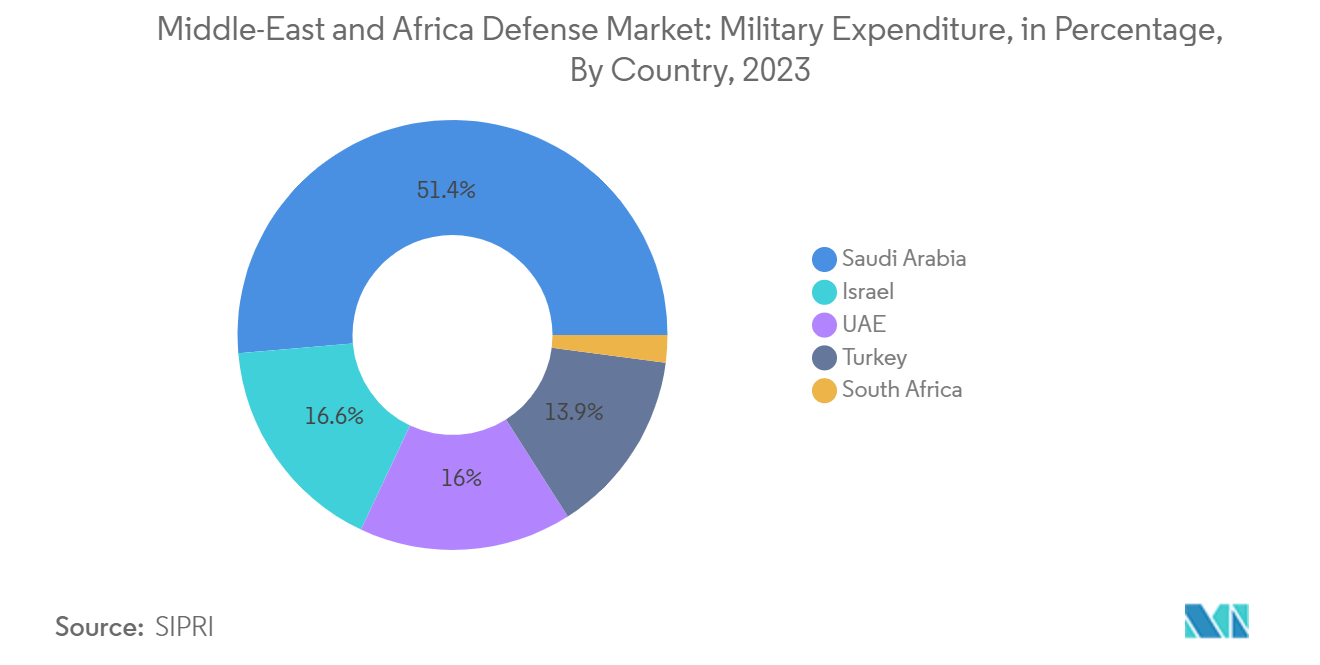
Saudi Arabia to Dominate Market Share During the Forecast Period
Saudi Arabia's dominant market share in the Middle East and Africa is driven by significant infrastructural investments, technological developments, and strategic initiatives envisaged in Vision 2030. Saudi Arabia has used large inflows of its oil revenues to diversify the economy in areas like defense, aerospace, and renewable energy. Growing factors include the creation of NEOM, a USD 500 billion smart city project, and substantial military procurement programs to enhance the capacity to protect itself. Moreover, Saudi Arabia's geography as a logistics hub allows for colossal trade and investment inflows. Other market growth drivers include the country's strategy for developing indigenous manufacturing capabilities and forging public-private partnerships.
Collaborations with international technology companies and defense contractors position Saudi Arabia's commitment to becoming a regional leader in innovation and economic diversification. The government's policy to transform the digital economy and invest in emerging technologies like AI and UAS should remain a leading factor in sustaining its market lead.
In February 2024, the Ministry of Defense of Saudi Arabia signed numerous strategic contracts and MoUs at the World Defense Show in Riyadh to reinforce military readiness and combat efficiency through manufacturing localization in line with the directions of Vision 2030. These include contracts with PrivatAir Saudi Arabia, LIG Nex1, Raytheon Saudi Arabia, Middle East Propulsion Co., SAAB Saudi Arabia, SAMI Aerospace and Maintenance Services, SAMI LAND Systems, Haji Husein Ali Reza & Co., Modern Technology Co., Saudi Arabian Thales International, Big Blue Pearl Co., and Saudi Information Technology Co. These signed contracts and MoUs reflect a big step toward enhancing the military readiness and capabilities of the Saudi Armed Forces while fostering local industry growth and technological advancement in line with national strategic objectives.
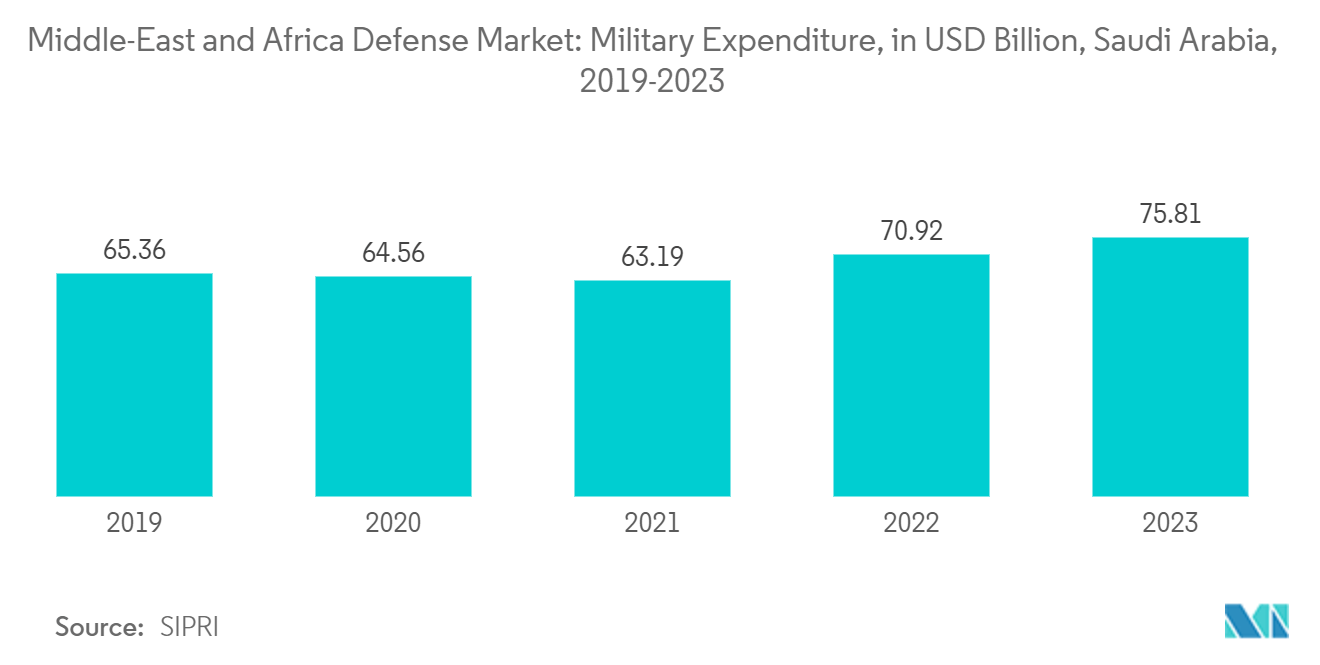
Middle East And Africa Defense Industry Overview
The Middle East and Africa defense market is fragmented, and market share is divided among regional and international players who provide their products and solutions to their respective domestic armed and security forces. Some prominent market players are The Boeing Company, Lockheed Martin Corporation, Saudi Arabian Military Industries, Israel Aerospace Industries Ltd, and BAE Systems PLC.
Elbit Systems Ltd, ASELSAN AS, Israel Aerospace Industries Ltd, and Denel SOC are some of the domestic players with an international presence that provides a wide range of military products, from portable military equipment for land forces to radars and other equipment onboard aircraft. SAMI spearheads the pivotal role of Saudi Arabia's Vision 2030 in localizing defense manufacturing, reducing dependence on foreign suppliers, and committing to substantial investment and strategic partnerships. IAI has robust aerospace and defense solutions in the form of UAVs, missile systems, international collaborations, and export activities.
Boeing and Lockheed Martin are regional international giants, supplying a wide range of military aircraft and defense systems. The growth of Boeing can be fueled by its extensive portfolio and ongoing contracts with regional governments, while strategic regional partnerships drive Lockheed Martin's market presence. Denel SOC Ltd, South Africa's largest defense company, produces diverse military equipment and has formed strategic alliances with global defense companies to enhance technological capabilities.
Government initiatives, like Saudi Arabia's Vision 2030, have been made toward enhancing the manufacturing of defense equipment locally, as this would encourage local industry growth and reduce foreign dependence. Continuous technological advancements and innovations, like the development of drones and missile defense systems, push the defense capabilities of the region even further. In March 2024, SAMI Navantia signed the agreement to support Saudi Vision 2030, which includes improving operational capabilities through integrating state-of-the-art technologies to satisfy the needs of the Royal Saudi Naval Forces. SAMI's state-of-the-art computer equipment and software investment is a mark of commitment to excellence and leadership in the naval systems industries. This center focuses on integrating and developing naval systems via high-performance software, with key focuses on artificial intelligence, cybersecurity, and unmanned vehicle integration to assure local capability and independence of operation.
Middle East And Africa Defense Market Leaders
-
The Boeing Company
-
Lockheed Martin Corporation
-
Saudi Arabian Military Industries
-
BAE Systems plc
-
Israel Aerospace Industries Ltd.
*Disclaimer: Major Players sorted in no particular order
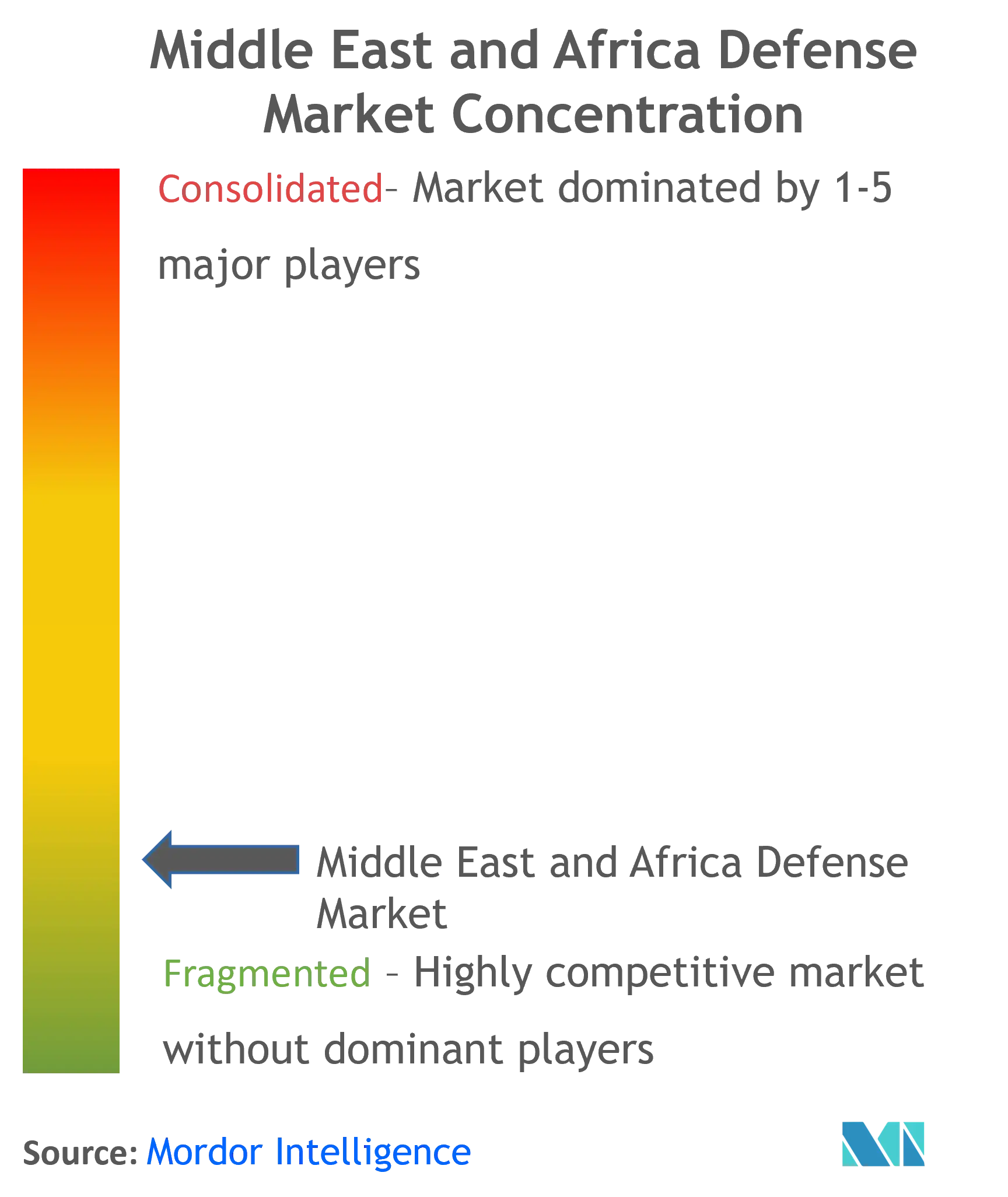
Middle East And Africa Defense Market News
- March 2024: The US State Department cleared a potential FMS for the Kingdom of Bahrain valued at about USD 2.2 billion. The proposed acquisition includes 50 M1A2 Abrams MBTs, four M88A2 Hercules Combat Recovery Vehicles, eight M1110 Joint Assault Bridges, other tanks/vehicles, and related equipment. This sale will make Bahrain join Kuwait and Saudi Arabia, which have purchased 436 and 526 M1A2 MBTs, respectively.
- February 2024: Allied Aeronautics signed an acquisition contract to procure four CN235-220 military transport aircraft for the Nigerian Army, manufacturer PT Dirgantara Indonesia (PTDI). It features an all-glass cockpit avionics system, an autopilot system, ramp doors, and winglets for added stability and fuel economy. Its ability to operate from short, unpaved runways adds to its versatility.
- January 2024: Saab AB and the UAE Ministry of Defence signed a contract for in-service support for the GlobalEye AEW&C. The order value is approximately USD 190 million, and the contract period is three years, ending in 2026. Saab will provide full-spectrum maintenance and operational support to the GlobalEye AEW&C, an imperative part of the UAE's state-of-the-art surveillance and reconnaissance capabilities.
Middle East & Africa Defense Market Report - Table of Contents
1. INTRODUCTION
- 1.1 Study Assumptions
- 1.2 Scope of the Study
2. RESEARCH METHODOLOGY
3. EXECUTIVE SUMMARY
4. MARKET DYNAMICS
- 4.1 Market Overview
- 4.2 Market Drivers
- 4.3 Market Restraints
-
4.4 Porter's Five Forces Analysis
- 4.4.1 Bargaining Power of Buyers/Consumers
- 4.4.2 Bargaining Power of Suppliers
- 4.4.3 Threat of New Entrants
- 4.4.4 Threat of Substitute Products
- 4.4.5 Intensity of Competitive Rivalry
5. MARKET SEGMENTATION
-
5.1 Procurement
- 5.1.1 Personnel Training and Protection
- 5.1.2 Communication Systems
- 5.1.3 Weapons and Ammunition
- 5.1.4 Vehicles
- 5.1.4.1 Land-based Vehicles
- 5.1.4.2 Sea-based Vehicles
- 5.1.4.3 Air-based Vehicles
-
5.2 MRO
- 5.2.1 Communication Systems
- 5.2.2 Weapons and Ammunition
- 5.2.3 Vehicles
-
5.3 Geography
- 5.3.1 Saudi Arabia
- 5.3.2 Turkey
- 5.3.3 Israel
- 5.3.4 Egypt
- 5.3.5 Algeria
- 5.3.6 South Africa
- 5.3.7 Morocco
- 5.3.8 Rest of Middle East and Africa
6. COMPETITIVE LANDSCAPE
- 6.1 Vendor Market Share
-
6.2 Company Profiles
- 6.2.1 SAMI
- 6.2.2 Emirates Defence Industries Company
- 6.2.3 Advanced Electronics Company
- 6.2.4 Military Industries Corporation
- 6.2.5 Dahra Engineering & Security Services LLC
- 6.2.6 Lockheed Martin Corporation
- 6.2.7 The Boeing Company
- 6.2.8 Elbit Systems Ltd
- 6.2.9 Israel Aerospace Industries Ltd
- 6.2.10 RTX Corporation
- 6.2.11 Rheinmetall AG
- 6.2.12 ASELSAN AS
- 6.2.13 Denel SOC Ltd
- 6.2.14 Northrop Grumman Corporation
- 6.2.15 BAE Systems PLC
- *List Not Exhaustive
7. MARKET OPPORTUNITIES AND FUTURE TRENDS
** Subject To AvailablityMiddle East And Africa Defense Industry Segmentation
The Middle East and African defense market analyzes different defense equipment used to maintain the region's military strength. The study covers all aspects and is expected to provide insights into budget allocation and spending in the Middle East and African defense market during the forecast period.
The Middle East and Africa defense market is segmented into procurement, MRO, and geography. By procurement, the market is segmented into personnel training and protection, communication systems, weapons and ammunition, and vehicles. Vehicles include land, air, and sea-based vehicles. MRO segments the market into communication systems, weapons, ammunition, and vehicles. The report also covers the market sizes and forecasts for the major countries across the region. The market sizing and forecasts have been provided in value (USD).
| Procurement | Personnel Training and Protection | |
| Communication Systems | ||
| Weapons and Ammunition | ||
| Vehicles | Land-based Vehicles | |
| Sea-based Vehicles | ||
| Air-based Vehicles | ||
| MRO | Communication Systems | |
| Weapons and Ammunition | ||
| Vehicles | ||
| Geography | Saudi Arabia | |
| Turkey | ||
| Israel | ||
| Egypt | ||
| Algeria | ||
| South Africa | ||
| Morocco | ||
| Rest of Middle East and Africa |
Middle East & Africa Defense Market Research FAQs
How big is the Middle East And Africa Defense Market?
The Middle East And Africa Defense Market size is expected to reach USD 138.41 billion in 2024 and grow at a CAGR of 5.09% to reach USD 177.40 billion by 2029.
What is the current Middle East And Africa Defense Market size?
In 2024, the Middle East And Africa Defense Market size is expected to reach USD 138.41 billion.
Who are the key players in Middle East And Africa Defense Market?
The Boeing Company, Lockheed Martin Corporation, Saudi Arabian Military Industries, BAE Systems plc and Israel Aerospace Industries Ltd. are the major companies operating in the Middle East And Africa Defense Market.
Which is the fastest growing region in Middle East And Africa Defense Market?
Middle East is estimated to grow at the highest CAGR over the forecast period (2024-2029).
Which region has the biggest share in Middle East And Africa Defense Market?
In 2024, the Middle East accounts for the largest market share in Middle East And Africa Defense Market.
What years does this Middle East And Africa Defense Market cover, and what was the market size in 2023?
In 2023, the Middle East And Africa Defense Market size was estimated at USD 131.36 billion. The report covers the Middle East And Africa Defense Market historical market size for years: 2019, 2020, 2021, 2022 and 2023. The report also forecasts the Middle East And Africa Defense Market size for years: 2024, 2025, 2026, 2027, 2028 and 2029.
Middle East & Africa Defense Industry Report
Statistics for the 2024 Middle East & Africa Defense market share, size and revenue growth rate, created by Mordor Intelligence™ Industry Reports. Middle East & Africa Defense analysis includes a market forecast outlook to 2029 and historical overview. Get a sample of this industry analysis as a free report PDF download.



